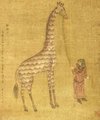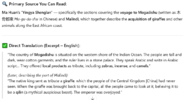You are using an out of date browser. It may not display this or other websites correctly.
You should upgrade or use an alternative browser.
You should upgrade or use an alternative browser.
Japanese people in Somalia during the Sengoku period (Tenshō embassy)
- Thread starter Waryaamus
- Start date
Fun fact :
The word "giraffe" in Japanese, "kirin, derived from the Somali word Giri for Giraffe has its roots in a historical connection between Somalia and Japan, stemming from the presentation of a giraffe to China (and subsequently to Japan) by Somali emissaries. The giraffe was initially mistaken for a mythical creature called a Qilin in China, and this name, "Kirin," was adopted into Japanese and Korean.
The word "giraffe" in Japanese, "kirin, derived from the Somali word Giri for Giraffe has its roots in a historical connection between Somalia and Japan, stemming from the presentation of a giraffe to China (and subsequently to Japan) by Somali emissaries. The giraffe was initially mistaken for a mythical creature called a Qilin in China, and this name, "Kirin," was adopted into Japanese and Korean.
Attachments
The biggest mystery is how the Muslims tapped in China, Central Asia and the sub continent in the medieval times but not Japan next door that had virtually no connection to the caliphates and local sultanates?
Surely that’s the biggest blunder considering old Japan would co-exist due to their similiar honor culture.
It was too late for the Ottomans who withdrew territories to save their homeland in WWI but could you imagine if the dawah happened 500+ years earlier?
Surely that’s the biggest blunder considering old Japan would co-exist due to their similiar honor culture.
It was too late for the Ottomans who withdrew territories to save their homeland in WWI but could you imagine if the dawah happened 500+ years earlier?
Last edited:
Barkhadle1520
VIP
This is false the earliest mention of the Qilin in Chinese litterature is in the 7th century BCE, the word has no somali roots.Fun fact :
The word "giraffe" in Japanese, "kirin, derived from the Somali word Giri for Giraffe has its roots in a historical connection between Somalia and Japan, stemming from the presentation of a giraffe to China (and subsequently to Japan) by Somali emissaries. The giraffe was initially mistaken for a mythical creature called a Qilin in China, and this name, "Kirin," was adopted into Japanese and Korean.
Here is a Qilin statue from the 4th century ce
The Chinese just slapped the word on the Giraffe because they thought it was that mythical beast, also I found no evidence of Somalis sending Giraffes to China, that one famous drawing depicted a Giraffe from Malindi
SOMALIA MENTIONED
Barkhadle1520
VIP
It was too far away and too big of a hastle for Muslim traders to sail all the way thereThe biggest mystery is how the Muslims tapped in China, Central Asia and the sub continent in the medieval times but not Japan next door that had virtually no connection to the caliphates and local sultanates?
Also, people think Japan was only cut off from the world during the Edo period but they were also partially cut off from world trade during the Kamakura and Muromachi period, only some Chinese and Korean traders would sail there with goods, Japan didnt even have any major international trading ports
Japan would never rise to be what we know today if they didnt have a big population that kept fighting each others
Diophantus
الشيخ المشككين
been baad naftaada u sheegtay. Giri kulaha lmfao.Fun fact :
The word "giraffe" in Japanese, "kirin, derived from the Somali word Giri for Giraffe has its roots in a historical connection between Somalia and Japan, stemming from the presentation of a giraffe to China (and subsequently to Japan) by Somali emissaries. The giraffe was initially mistaken for a mythical creature called a Qilin in China, and this name, "Kirin," was adopted into Japanese and Korean.
Zheng He expedition to the Somali Coast is documented in his Book - which is a primary sourceThe Chinese just slapped the word on the Giraffe because they thought it was that mythical beast, also I found no evidence of Somalis sending Giraffes to China, that one famous drawing depicted a Giraffe from Malindi
This is direct proof of the Somali introduction of the Giraffe to the Chinese - Cope harder bro
Attachments
Nevermind reading that excerpt again I realized I was mistaken, however the introduction of Zebras to the Chinese can definitely be attributed to us considering this text
Also do you guys know the status of Malindi at the time was it owned by a foreign entity perhaps Somalis or Omanis, or it was it an independent City state ran locally by the Bantu speaking people there?
Barkhadle1520
VIP
Zheng He expedition to the Somali Coast is documented in his Book - which is a primary source
This is direct proof of the Somali introduction of the Giraffe to the Chinese - Cope harder bro
Quotes Chatgpt, which is known to make up quotes
It's also funny how you immidiately try to claim Malindi was Somali when proven wrong, always the same thing with you arrogant people, can't accept that you were fed lies all this time so you resort to claiming others history, really embarassing behavior, instead of believing what you see on Tiktok about Somali history why don't you research it yourself
By the way Macrobia wasn't in Somalia, might wanna start considering a new username

cunug3aad
3rdchild · Beelweynta Islaamiga
Are you just talking to say stuff sometimes. No one knows where exactly macrobia was just that the tall descriptos and geographical location probably sounds like somalis ancestors. Not everything is gonna match up when the explorers are before islaam and before christianityBy the way Macrobia wasn't in Somalia, might wanna start considering a new username
Barkhadle1520
VIP
You're right, we wuz kangs.Are you just talking to say stuff sometimes. No one knows where exactly macrobia was just that the tall descriptos and geographical location probably sounds like somalis ancestors. Not everything is gonna match up when the explorers are before islaam and before christianity
cunug3aad
3rdchild · Beelweynta Islaamiga
Thats more like itYou're right, we wuz kangs.

Still can't unprove the fact that we introduced zebras to them which is a cooler animal than a giraffe in my opinionQuotes Chatgpt, which is known to make up quotes

Barkhadle1520
VIP
We introduced zebras n shietStill can't unprove the fact that we introduced zebras to them which is a cooler animal than a giraffe in my opinion
I don't know about a Somali connection with the word Giraffe but there was plenty of trade and relations with China.Fun fact :
The word "giraffe" in Japanese, "kirin, derived from the Somali word Giri for Giraffe has its roots in a historical connection between Somalia and Japan, stemming from the presentation of a giraffe to China (and subsequently to Japan) by Somali emissaries. The giraffe was initially mistaken for a mythical creature called a Qilin in China, and this name, "Kirin," was adopted into Japanese and Korean.
Speaking of Korea, there was actually a small Muslim community in medieval Korea with artifacts found from the Middle East as well. There is also a Persian epic that partially takes place in Korea called Kush Nama. So Medieval Muslims were aware of places as far as Korea but Japan was probably unknown.
How dare you doubt the great microbian kingdom that ruled the world?View attachment 368992
View attachment 368995
View attachment 368998
View attachment 368999
View attachment 369000
View attachment 369001
View attachment 369002
View attachment 369004
View attachment 369005
Quotes Chatgpt, which is known to make up quotes
It's also funny how you immidiately try to claim Malindi was Somali when proven wrong, always the same thing with you arrogant people, can't accept that you were fed lies all this time so you resort to claiming others history, really embarassing behavior, instead of believing what you see on Tiktok about Somali history why don't you research it yourself
By the way Macrobia wasn't in Somalia, might wanna start considering a new username

Trending
-
My Biggest Fear is Marrying a Woman with Dhagax Hair and That’s Okay
- Started by Gacmeey
- Replies: 149
-
-


 .
.
